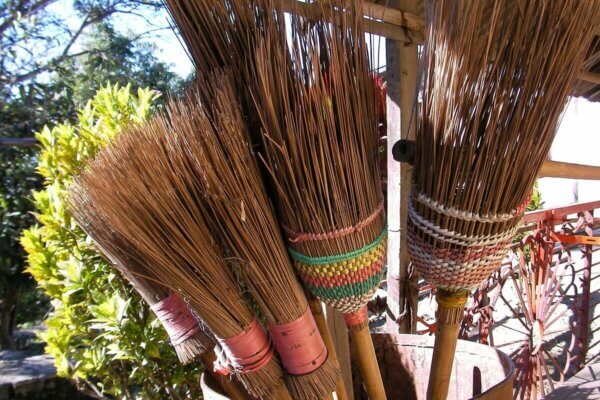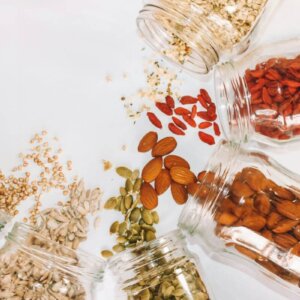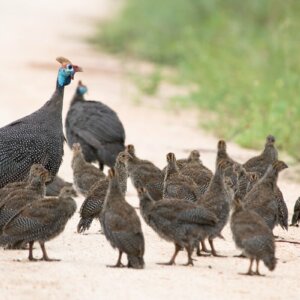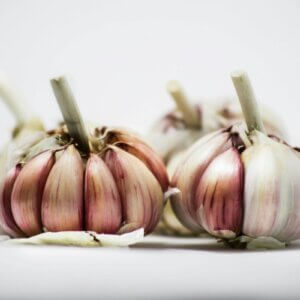If you’re getting through the long, dark days of winter reading the seed catalogs and dreaming of having your hands in the dirt, you may want to consider adding some new and visually exciting plants to your homestead landscape. Broom corn fits the bill.
Native to Central Africa, broom corn, (Sorghum vulgare) a variety of sorghum in the plant family Poaceae, is a beautiful addition to the garden: a plant with a diverse array of uses, both functional and ornamental. A hardy annual, broom corn, also known as broom straw, is a tall grass that forms broad, imposing tasseled, fan-shaped heads, ranging from 12-20 inches long.
https://www.instagram.com/p/BZ2IINZjLK_/?tagged=broomcorn
Requiring a bright and sunny open location and flourishing in nutrient-rich, well-drained soil, broom corn reaches heights of 10-18 feet at maturity, depending on the variety. Unlike its cousin, sweet corn, broom corn produces attractive seed heads rather than edible ears.
Varieties Of Broom Corn
When shopping for seeds, you will find that there are three different types of broom corn: Western dwarf, whisk dwarf, and standard. Standard broom corn, the most popular and widely planted, grow the tallest and bear a brush from 12-36 inches in length.
Popular standard varieties include California golden, black Spanish, also known as black jap, and evergreen. Western dwarf and whisk dwarf are types of broom corn used for whisk and fireplace brooms and extensively used in floral arrangements.
https://www.instagram.com/p/BaH3woiB4UA/?tagged=broomcorn
Broom corn seed, in a wide range of colors, is available from local home and garden centers or can be purchased from heirloom seed dealers online. Popular varieties include Japanese dwarf, Moyer Jensen gold, white popping, Hungarian red, Texas black-seeded, Ramirez sweet chili, and Apache red.
Try several different varieties, the colors are bold and brilliant shades of red, brown, orange, yellow, black, and creamy white. The Texas black-seeded variety is especially attractive for use in floral arrangements when the seeds mature and turn a shiny, inky black. Birds love all varieties of broom corn seeds.
Purchase individual varieties of broom corn or plant Sorghum bicolor, a genetic name for a colorful mixture of multiple varieties of broom corn. Collecting the tasseled seed heads and drying at different stages of maturation will provide a beautiful spectrum of colors from any given broom corn plant.
https://www.instagram.com/p/BZdwq1YDGd7/?tagged=broomcorn
Dependent on the variety, broom corn requires 90-110 days before it is mature, ripe, and ready for harvest. Broom corn will grow in any United States Plant Hardiness Zone climate that supports the cultivation of sweet corn. If field-grown, rows of broom corn can be planted as dividers between different varieties of field corn or sweet corn.
Tips For Growing Broom Corn
Broom corn is heat and drought-tolerant with a natural resistance to plant diseases, insects, and mold– it may be the easiest plant your have ever grown. Purchase seeds from local farm and feed stores, home and garden centers, or online seed sellers.
- Broom corn is best planted in late spring between early May and the middle of June after all chance of a late frost has passed. Broom corn does best in a full-sun location.
- Prepare the soil by deep tilling, removing all rocks, roots, and debris.
- Supplement the soil with generous amounts of well-aged herbivore manure (cow, donkey, mule, horse, sheep, goat, or llama). Work the manure well into the soil, breaking up dirt clogs until the soil has a mealy texture.
- Plant seeds at a depth of about 1 inch, with rows spaced 3-4 feet apart and seeds planted in rows with a minimum of 2 feet between each seed in the row. Water well.
- Wide spacing ensures that each plant has plenty of room to mature. Broom corn thrives on lots of water, but the garden plot or field must be well drained to prevent root rot.
After planting, bright green shoots will appear in about a week. Broom corn is a slow grower until the plants reach about a foot high, then they just seem to shoot up overnight with some varieties growing to an impressive height of 15 feet or more.
As the plant matures and each group of plumes or tassels forms, but before it sets seed, gently bend the stalk over in a graceful arch, allowing the heavy seed heads to hang down naturally until harvest time.

Carefully shape tassels in mid to late-August for harvest in September before seed heads have a chance to mature. Lush and full pendant plumes make the finest brooms. If you forget to gently bend the stalks and plumes are left upright, they dry up on the plant causing the broom straws to splay and separate.
Although broom corn is a hardy annual it reseeds readily, quickly establishing in barren areas. Seeds spread by nature will likely sprout up too close to each other to allow the plant room to mature. Allow the most robust and vigorous plants to remain, weeding out the rest.
Harvesting And Drying Broom Corn
Broom corn is typically ready for harvesting when the plant has developed the ideal tassel or “brush” for broom-making. The hardy plant typically exhibits the best brush when the plant is still in flower and the seeds are only slightly developed. Planted in the spring, broom corn is ready for cutting by the harvest moon of October.
https://www.instagram.com/p/BLKPq1RAWWj/?tagged=broomcorn
Each plume or brush is composed of a massive cluster of individual straws, joined together at the base of where each cluster meets the stem or stalk. A ton of dried broom corn tassels is enough to produce 80 to 100 brooms.
- A high-quality broom corn brush exhibits a rich, bright green colored stalk with tassels free from discoloration. Fibers should be pliable, smooth and straight. A standard household broom requires broom corn straw fibers that are approximately 18-22 inches long. Brushes that are bleached, overripe, coarse, or crooked are considered sub-quality.
- When it’s time to harvest broom corn, cut stalks with a sharp knife or machete, leaving a long stem. Each stack is then hung upside down to dry or laid flat on drying racks. Drying time is approximately three weeks when stalks are hung in a warm, covered, well-ventilated space.
- When the tassels are used for broom-making, excess seeds can be removed by “combing” each tassel with a wide-toothed comb.
- Excess broom corn seeds can be saved for next spring’s planting.
Crafting A Traditional Broom Corn Broom
If you’re a fan of the Harry Potter movies, a fun tidbit is that a small artisan broom-making studio, North Woven Broom Co. of Crawford Bay, British Columbia, Canada handcrafted brooms for the marketing of the books. The broom corn straw they organically cultivate is from their lakeside homestead.
Here is an artist from North Woven Broom who gives us a glance into the process. Pretty neat, huh?
My cabin proudly boasts three of these brooms, a whisk broom, a fireplace broom, and a household broom. I had the pleasure of seeing the brooms made, attached to wind and sand-polished aspen driftwood handles I chose from the studio’s abundant collection of freshwater driftwood.
How To Make Your Own Broom
To craft your own traditional broom, soak two bundles, per broom, in warm water for 10 minutes to facilitate handling. Bind the bundles to the handle with leather strapping. Before using the leather to bind the broom corn bundles, soak the leather in water so that it shrinks tightly when dried, firmly securing the straw bundles to the handle.
Secure with small copper nails, driven into each side of the handle at the area where the bundles and handle join. To maintain your broom in good condition, hang from a hook or store it with the broom bottom upright when not in use.
https://www.instagram.com/p/BSZRlWMD5GC/?tagged=broommaking
If the broom is stood with the broom end pointing down, leaning in the corner, broom straw tends to bend, damaging the visual appearance and usefulness of the broom.
Here is a great video that gives you an idea of what it looks like to craft your own broom:
A Bit About The History Of Broom Corn
Although Benjamin Franklin is credited with introducing broom corn to the United States, it wasn’t until 1787 when a Massachusetts farmer, Levi Dickenson, crafted a stout and extremely good broom from a bundle of broom corn that the popularity of the plant grew.

Dickenson had some great ideas, but it seems it took him a while to implement them. Some 23 years later, in 1810, Dickerson invented a foot-treadle broom-making machine and commenced commercial production of his “new-fangled” household broom.
By the mid-1830s, commercial broom corn broom production factories were springing up across the Northeast states and began moving west. To meet the huge demand for broom corn, thousands and thousands of acres of the profitable plant were cultivated annually.
https://www.instagram.com/p/Bd2iH08lvWf/?taken-by=broomworks
In the mid-1970s, more than 100,000 acres of America’s heartland was dedicated to the production of broom corn. Today, broom corn is cultivated commercially throughout the Midwest, Texas, and Oklahoma.
Today, in homesteads across America, cultivating broom corn is gaining great popularity, as both an ornamental landscape plant and as an attractive, easy-to-grow, supplemental cash crop.
https://www.instagram.com/p/Bdk3Q4fjBfE/?tagged=broommaking
Broom corn, also known as broom straw, is an eye-catching ornamental plant, used as a flowerbed backdrop, against a fence line, or planted in staggered rows to hide unsightly views. By mid-autumn, broom corn exhibits brightly colored, giant seed heads.
The plant, sold fresh or harvested and dried in the fall, is always a sell-out at the farmer’s market, purchased by crafters for use in making brooms, whisk brooms, wreaths, and floral arrangements.
References
- Broom Corn, Washington State University Extension
- Alternative Crops Manual – Broom Corn, University Of Wisconsin Extension
- Broom Corn Production In Iowa, Iowa State University








































Hello,
Great read, thanks!
I don’t have the room to grow that much sorghum for broom making… but do you happen to know where it can be purchased in Canada?
Thanks!